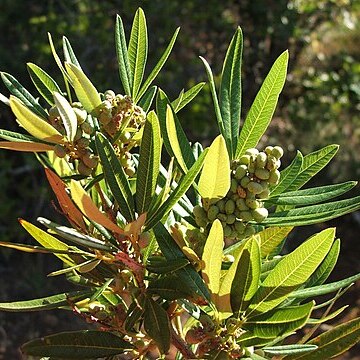Erect, suffrutescent, thicket-forming shrub up to 1.5 m, occasionally small tree up to 4 m. Branches glabrous, reddish, minutely lenticellate, branchlets ascending. Leaves trifoliolate, petiolate, petiole semiterete, flattened above, (5-)8(-19) mm long; leaflets coriaceous, discolorous, dark grey-green and glabrous above, creamy canescent and tomentose below, hypostomatous, petiolulate, petiolule canaliculate above, 1-5 mm long; lamina lanceolate to narrowly elliptic, base cuneate, apex subacute to acute, mucronulate; margin entire, slightly thickened; venation simple-to semicraspedodromous, midrib dull yellow, prominent below, impressed above, secondaries slightly prominent below, impressed above, tertiaries impressed or obscure; terminal leaflets (24-)52(-86) x (5-)10(-21) mm, lateral leaflets (11-)41(-67) x (3-)7(-16) mm. Panicles much branched, flowers crowded, males up to 80 mm long, odoriferous, females up to 40 mm, axillary and terminal, exposed. Flowers normal, calyx pubescent. Drupe oblate, elliptic, creamy canescent, shortly villous-tomentose, 5.2 x 3.0-5.6 x 3.3 mm.
More
A shrub, with brown branches. Petiole 0.5 inch or longer, flat above, lateral petioles 2 lines, the terminal 3-4 lines long. Leaflets 2-2.5 inches long, 4-6 lines wide, green, with impressed middle nerve above, whitish or yellowish tomentose below, lomewhat red in the prominent middle nerve. Flowers white, 0.5 line long. Panicles 2-5 inches long, pyramidal. Pedicels capillary, bracteate at the base. Drupe the ifcse of a pea. In a few specimens the ultimate branchlets and petioles are thinly pubescent. Very similar to B. laneea, Thunb., but distinguished by the tomentose leaflets and the drupe.
Dioecious, evergreen shrub or small tree to 4 m. Leaves trifoliolate, leaflets stalked, lanceolate to narrowly elliptic, discolorous. Flowers yellowish. Drupes ellipsoid, shortly hairy.


